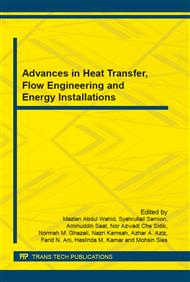[1]
K. Uehara, S. Murakami, S. Oikawa, S. Wakamatsu, Wind tunnel experiments on how thermal stratification affects flow in and above urban street canyons, Atmospheric Environment. 34 (2000) 1553-1562.
DOI: 10.1016/s1352-2310(99)00410-0
Google Scholar
[2]
Ansys (2011). ANSYS Release 14. 0. User's Guide, Canonsburg, ANSYS Inc.
Google Scholar
[3]
Y. Tominaga, A. Mochida, T. Shirasawa, R. Yoshie, H. Kataoka, K. Harimoto, T. Nozu, Cross comparisons of CFD results of wind environment at pedestrian level around a high-rise building and within a building complex, Journal of Asian architecture and building engineering. 3 (2004).
DOI: 10.3130/jaabe.3.63
Google Scholar
[4]
Y. Tominaga, A. Mochida, R. Yoshie, H. Kataoka, T. Nozu, M. Yoshikawa, T. Shirasawa, AIJ guidelines for practical applications of CFD to pedestrian wind environment around buildings, Journal of Wind Engineering and Industrial Aerodynamics. 96 (2008).
DOI: 10.1016/j.jweia.2008.02.058
Google Scholar
[5]
E. Ng, L. Katzschner, U. Wang, C. Ren, L. Chen, Working Paper No. 1A: draft urban climatic analysis map–urban climatic map and standards for wind environment–feasibility study, Technical Report for Planning Department HKSAR, Report No. WP1A, Planning Department of Hong Kong Government: Hong Kong, (2008).
DOI: 10.4324/9781315717616
Google Scholar
[6]
J. Franke, Recommendations of the COST action C14 on the use of CFD in predicting pedestrian wind environment, in: The fourth international symposium on computational wind engineering, Yokohama, Japan, 2006, 529-532.
Google Scholar
[7]
J. Franke, A. Hellsten, K.H. Schlunzen, B. Carissimo, (Eds. ), Best practice guideline for the CFD simulation of flows in the urban environment, COST Action 732, quality assurance and improvement of microscale meteorological models, Brussels, COST office, (2007).
DOI: 10.1504/ijep.2011.038443
Google Scholar
[8]
J. Franke, C. Hirsch, A.G. Jensen, H.W. KruS, M. Schatzmann, P.S. Westbury, S.D. Miles, J.A. Wisse, N.G. Wright, Recommendations on the use of CFD in wind engineering, in: Proceedings of the International Conference on Urban Wind Engineering and Building Aerodynamics, in: van Beeck, J.P.A.J. (Ed. ), COST Action C14, Impact of Wind and Storm on City Life Built Environment, 5–7 May 2004 von Karman Institute, Sint-Genesius-Rode, Belgium.
DOI: 10.5359/jawe.35.63
Google Scholar
[9]
S.H.L. Yim, J.C.H. Fung, A.K.H. Lau, S.C. Kot, Air ventilation impacts of the wall effect, resulting from the alignment of high-rise buildings. Atmospheric Environment. 43 (2009) 4982-4994.
DOI: 10.1016/j.atmosenv.2009.07.002
Google Scholar
[10]
X-X. Li, C-H. Liu, D.Y.C. Leung, Development of a k-ϵ model for the determination of air exchange rates for street canyons, Atmospheric Environment. 39 (2005) 7285-7296.
DOI: 10.1016/j.atmosenv.2005.09.007
Google Scholar
[11]
C-H. Liu, D.Y. Leung, M.C. Barth, On the prediction of air and pollutant exchange rates in street canyons of different aspect ratios using large-eddy simulation, Atmospheric Environment. 39 (2005) 1567-1574.
DOI: 10.1016/j.atmosenv.2004.08.036
Google Scholar
[12]
X. Xie, C-H. Liu, D.Y. Leung, M.K. Leung, Characteristics of air exchange in a street canyon with ground heating. Atmospheric Environment. 40 (2006) 6396-6409.
DOI: 10.1016/j.atmosenv.2006.05.050
Google Scholar
[13]
X. Xie, Z. Huang, J-S. Wang, Impact of building configuration on air quality in street canyon, Atmospheric Environment. 39 (2005) 4519-4530.
DOI: 10.1016/j.atmosenv.2005.03.043
Google Scholar
[14]
J-S. Wang, Z. Huang, Numerical study on flow and dispersion in rban street canyons of asymmetrical configurations, Journal of Hydrodynamics, Ser. B. 18 (2006) 146-150.
DOI: 10.1016/s1001-6058(06)60045-0
Google Scholar
[15]
J-S. Wang, B-Q. Zhao, C. Ye, D-Q. Yang, Z. Huang, Optimizing layout of urban street canyon using numerical simulation coupling with mathematical optimization, Journal of Hydrodynamics, Ser. B. 18 (2006) 345-351.
DOI: 10.1016/s1001-6058(06)60015-2
Google Scholar


